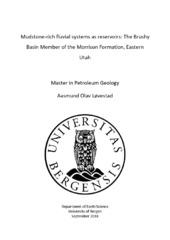| dc.contributor.author | Løvestad, Aasmund Olav | |
| dc.date.accessioned | 2018-10-02T15:56:37Z | |
| dc.date.issued | 2018-09-27 | |
| dc.date.submitted | 2018-09-26T22:00:04Z | |
| dc.identifier.uri | https://hdl.handle.net/1956/18614 | |
| dc.description.abstract | Mudstone-rich fluvial systems are common in the sedimentary record, such as the Triassic of the Barents Sea, but have received little scientific attention compared to their sandstonerich counterparts. However, mudstone-rich fluvial systems often have large river channels which are easily imaged on seismic data, and thus make good exploration targets. The late stages of the Jurassic sedimentary succession of Utah, USA, comprise of a collection of lowgradient, mudstone-rich fluvial continental deposits known as the Brushy Basin Member of the Morrison Formation. This thesis investigates the Jurassic Brushy Basin Member as an analogue to mudstone-rich fluvial reservoirs and offers new insight into distributary fluvial systems. Fieldwork was done on a 2x2 km, v-shaped outcrop which offers a high degree of threedimensionality. Data acquisition was done through combining traditional fieldwork techniques with modern digital acquisition techniques and a virtual model of the outcrop was constructed. Through interpreting and correlating logs with the virtual-outcrop, facies associations and their spatial organization was identified and understood. A conceptual geological model was constructed which schematically captures the upwards changes in the fluvial system. A reservoir model based on the geological model was then built with the goal of flow-simulating oil production from the reservoir model. The results from studying the Brushy Basin Member implies a retrograding distributary fluvial system, with an upwards decrease in channel-belt width, thickness, amalgamation and interconnection. This interpretation has not been described in previous work. Production results from flow simulating the reservoir model shows that a mudstone-rich fluvial system highly depend on channel-to-channel connection which can be established through crevasse-splays. In exploration of new and poorly understood mudstone-rich fluvial systems, sub-seismic channels and crevasse-splays should be considered an upside in terms of connectivity and reservoir volumes. | en_US |
| dc.language.iso | eng | eng |
| dc.publisher | The University of Bergen | en_US |
| dc.subject | Morrison Formation | eng |
| dc.subject | Distributary fluvial systems | eng |
| dc.subject | Colorado Plateau. | eng |
| dc.subject | Virtual outcrop | eng |
| dc.subject | Mudstone-rich fluvial systems | eng |
| dc.subject | Brushy Basin Member | eng |
| dc.subject | Crevasse-splays | eng |
| dc.subject | Mudstone | eng |
| dc.subject | Fluvial sedimentologi | nob |
| dc.subject | Fluviale prosesser | nob |
| dc.subject | Sedimentære bergarter | nob |
| dc.title | Mudstone-rich fluvial systems as reservoirs: The Brushy Basin Member of the Morrison Formation, Eastern Utah | en_US |
| dc.type | Master thesis | |
| dc.date.updated | 2018-09-26T22:00:04Z | |
| dc.rights.holder | Copyright the Author. All rights reserved | en_US |
| dc.description.degree | Masteroppgave i geovitenskap | en_US |
| dc.description.localcode | MAMN-GEOV | |
| dc.description.localcode | GEOV399 | |
| dc.subject.realfagstermer | https://data.ub.uio.no/realfagstermer/c005603 | |
| dc.subject.realfagstermer | https://data.ub.uio.no/realfagstermer/c006354 | |
| dc.subject.realfagstermer | https://data.ub.uio.no/realfagstermer/c013254 | |
| dc.subject.nus | 756199 | eng |
| fs.subjectcode | GEOV399 | |
| fs.unitcode | 12-50-0 | |
| dc.date.embargoenddate | 2019-09-19 | |
